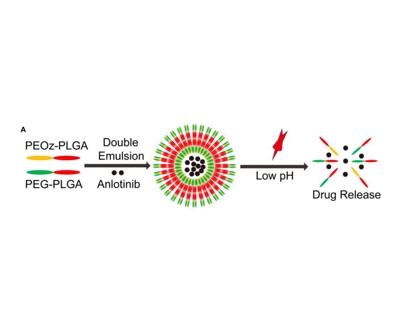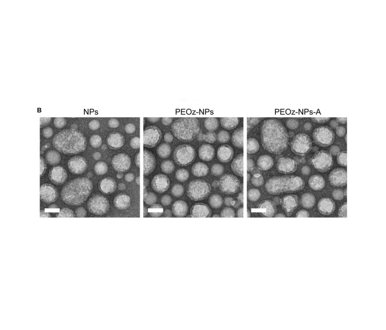文献:Tumor-Acidity Responsive Polymeric Nanoparticles for Targeting Delivery of Angiogenesis Inhibitor for Enhanced Antitumor Efficacy With Decreased Toxicity
文献链接:https://pubmed.ncbi.nlm.nih.gov/33842451/
作者:Xiufeng Cong, Jun Chen,Ran Xu
相关产品:
(PEOz)-poly-PLGA 聚(2-乙基-2-噁唑啉)-poly-聚乳酸羟基乙酸共聚物
L-lactic L - 乳酸
原文摘要:Various nanocarriers with tumor targeting ability and improved pharmacokinetic
property have been extensively utilized to reduce the toxicity of existing clinical chemotherapeutics. Herein, we showed that by encapsulating angiogenesis inhibitor anlotinib into polymeric nanoparticles, we could significantly decrease its in vivo toxicity. The introduction of pH-responsiveness into the nanocarrier further enhanced its antitumor activity. Systemic administration of the anlotinib-loaded nanocarrier into mice bearing A549 and 4T1 subcutaneous tumor received a higher tumor growth suppression and metastasis inhibition without detectable side effects. This strategy offers a promising option to improve the patient compliance of anlotinib.
含盐酸安洛替尼的tumour酸性反应性聚合物纳米载体可以抗tumour活性,降低副作用。在合成过程中,将ph响应性聚合物材料PEOz-PLGA引入纳米颗粒的结构中,并赋予纳米颗粒具有ph响应性特性。体外药物释放研究和细胞活力试验均表明,PEOz-NP-A在低pH条件下可快速释放包膜药物,并表现出增强的tumour细胞杀伤效果。PEOz-NP-A与相应的对照组相比,能抑制tumour生长,且无明显的副作用。

图为:ph响应性纳米颗粒PEOz-NPs的制备示意图
NPs的特性
利用生物相容性聚合物PEG-PLGA,采用先前报道的双乳化液法构建了负载安洛替尼的纳米颗粒(NPs-A)。为了实现ph响应性,在制备过程中,将ph敏感的聚合物材料PEOz-PLGA混合到PEG-PLGA溶液中,形成ph响应性纳米颗粒(PEOz-NPs-A)。首先使用不同比例的聚合物材料和药物来优化载药效果。当封装效率(EE)的比例提高时,加载效率(LE)达到最大值。采用透射电电子显微镜(TEM)对纳米颗粒的形貌进行表征。结果表明,PEOz-NPs-A表现出典型的核壳结构(图1B)。接下来,通过DLS分析和药物释放研究来评估PEOzNPs-A纳米颗粒对酸性环境的反应性。药物释放结果表明,PBS孵育后,从PEOz-NPsA中释放安洛替尼,而在PEOz-NPs-A中仅释放少量安洛替尼。这两个结果都表明,PEOz-NPs-A在弱酸性环境中解离,并以ph依赖的方式快速释放其装载的货物。最后,利用DLS方法对PEOz-NPs-A的稳定性进行了评价。在储存期间,没有观察到大小和zeta电位的明显变化。

图为:NPs、PEOzs-NPs和PEOzs-NPs-A的TEM成像和DLS
结论:ph响应聚合物纳米载体PEOz-NPs-A,体外药物释放谱和细胞活力试验证明了该纳米载体的成功构建。体内抗tumour实验显示,tumour抑制和转移抑制有改善。抑制转移的一个潜在机制是原发tumour的减少,导致不同Treatment 组的tumour大小不同。

 2025-02-11 作者:lkr 来源:
2025-02-11 作者:lkr 来源:

